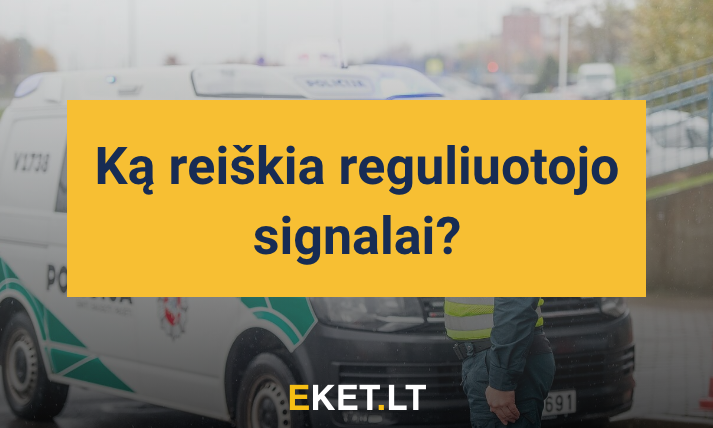What do the regulator signals mean?
Although traffic controllers are extremely rare on the roads, it is important to remember and know what the different signals from a controller mean.
Ekis Paprastai
2025 September 19
3 min. read

Who is a regulator?
A traffic controller is a person authorized to regulate road traffic, wearing a uniform and/or having a distinctive sign (armband, traffic controller's baton, red reflector). A traffic controller is usually a police officer, but may also be a crossing guard, road worker, or other person authorized to regulate traffic. The traffic controller usually stands in the middle of the intersection.
The regulator's instructions take precedence with regard to traffic light signals, road signs and road markings, as well as the requirements of the Highway Code.
Traffic controller signals are displayed by different hand positions of the controller, and a whistle is used to announce that the controller's instructions will soon change.
Traffic signals are an important part of the Road Traffic Act (RTA) as they are used to regulate traffic, especially in situations where traffic lights are not working or when traffic conditions require direct control. Paid and free RTA tickets include questions about traffic signals, as this knowledge is essential for all drivers.
What do the regulator signals mean?
Arms outstretched to the sides or lowered
Driving straight and to the right is allowed from the right and left sides.
Pedestrians are allowed to cross the roadway from the right and left sides.
All vehicle and pedestrian traffic is prohibited from the chest and back.
Right arm extended forward
Driving in all directions is allowed from the left side.
From the chest side, only right-hand travel is allowed.
All vehicle traffic is prohibited from the rear and right side.
Pedestrians are allowed to cross the roadway behind the traffic controller.
Hand raised up
Everyone is prohibited from moving in any direction.
Everyone must stop without changing lanes.
What are the other signals from the regulator?
The driver must stop the vehicle, the pedestrian must stop when the inspecting officer or the traffic controller gives a signal - waving the traffic controller's stick or a circle with a red reflector directed at the road user, or ordering to stop through a loudspeaker. The STOP signal may also be indicated in special colors and on a light board installed in a marked car with the relevant service mark.
In order to attract the attention of road users, the inspecting officer or regulator may blow a whistle. Upon receiving a signal to stop, the driver must immediately stop the vehicle at the indicated place ; if no place is indicated, on the right shoulder of the road, and if there is no shoulder of the road, on the right edge of the carriageway.
Frequently asked questions
Here you will find answers to common questions. If you did not find your question, click Contact us and we will gladly help.

Did not find an answer?
Contact us and we will help!
Information updated 2025-09-19
Related articles

2025 September 19
2 min. read
Braking distance/stopping distance
Ekis Paprastai

2025 September 19
7 min. read
Categories A, A1, A2, AM
Ekis Paprastai

2025 September 19
4 min. read
Vehicle Categories and Their Classification (Descriptions)
Ekis Paprastai

2025 September 19
7 min. read
B, B1, BE Categories
Ekis Paprastai
Other articles
Regitra Exam Fees – Theory and Practical License Costs
When do you need to retake your driving license? [2025 Information]
(NON) Critical Errors at Regitra: Possible Error Types 2025
Car dashboard symbols and their meanings
Driving with the M Plate: Requirements, Opportunities, Pros and Cons, FAQ
Beginner Driver: License, Tips, Traffic Violations
Best KET tests (tickets) 2025
Driving exam 2025: school test, at Regitra, mistakes
Tractor driving license: categories, requirements, costs
C kategorija
KET Speed Table 2025 PDF (permitted driving speeds)
Driving categories 2025: Descriptions, requirements, notes
Lost driver's license: recovery, retaking exams, required documents
Regitra questions – 20 questions before the practical exam 2025
EKET.LT - More than just KET tests
EKET.LT is an innovative learning system helping you prepare for the Regitra theory exam. You will find not only KET tickets and tests here, but also constantly updated content, learning statistics, recommendations and the option to consult with an experienced instructor. Learn more effectively, track your progress and get ready to pass on the first try.
Copying or reusing any material published on “EKET.LT” is prohibited. 2021 - 2025.

